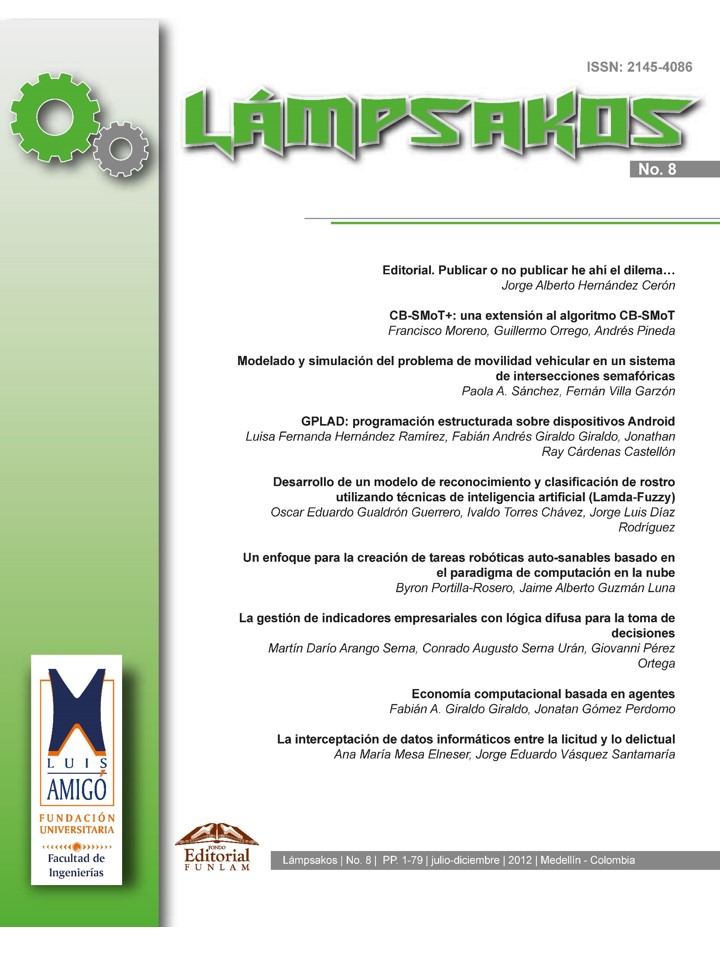Modelado y Simulación del Problema de Movilidad Vehicular en un Sistema de Intersecciones Semafóricas
DOI:
https://doi.org/10.21501/21454086.674Keywords:
Simulación, Movilidad vehicular, Semáforos, Congestión, Control de tráfico,Abstract
En el contexto global se percibe un aumento del parque automotor. Fenómeno que, entre otros requerimientos, demanda sistemas de tráfico eficientes que respondan al volumen de vehículos que hacen uso de las vías y garanticen una adecuada movilidad. No obstante, esta visión no se corresponde con lo que sucede actualmente en las vías de las medianas y grandes ciudades que presentan problemas complejos de movilidad. El mayor impacto de las reducciones en la movilidad se encuentra en las congestiones de tráfico en sistemas de intersecciones semaforizadas. En este artículo se modela un sistema de semáforos en Medellín y se simulan, como solución, diferentes distribuciones en los tiempos de los semáforos. Los resultados encontrados con la simulación mejoran el comportamiento real y permiten sugerir políticas para el control de tráfico en la ciudad, de acuerdo con el número de vehículos.Downloads
References
A. M. d. V. d. Aburrá, «Área Digital,» 16 de agosto 2012. [En línea]. Available: http:// www.areadigital.gov.co/Documents/EOD%20 Medellin%20150812.pdf. [Último acceso: 10 Octubre 2012].
A. D’Ambrogio, G. Lazeolla, L. Pasini y A. Pieroni, «Simulation model building of traffic intersections,» Simulation Modelling Practice and Theory, vol. 17, pp. 625-640, 2009.
M. Wegener, «The future of mobility in cities: Challenges for urban modelling,» Transport Policy, p. in press, 2012.
F. Basile, P. Chiacchio y D. Teta, «A hybrid model for real time simulation of urban traffic,» Control EngineeringPractice, vol. 20, pp. 123- 137, 2012.
J. Vasic y H. Ruskin, «Cellular automata simulation of traffic including cars and bicycles,» Physica A, vol. 391, pp. 2720-2729, 2012.
J. Guerrero, P. Damián, C. Flores y P. Llamas, «Plataforma para Gestión de la Red de Semáforos de Zonas Urbanas,» Revista Iberoamericana de Sistemas, Cibernética e Informática, vol. 7, nº 1, pp. 12-18, 2010.
J. Taplin, «Simulation Models of Traffic Flow,» de The 34th Annual Conference of the Operational Research Society of New Zealand , New Zealand, 1999.
C. Dangond, J. Jolly, A. Monteoliva y F. Rojas, «Algunas reflexiones sobre la movilidad urbana en Colombia desde la perspectiva del desarrollo humano,» Papel Político, vol. 16, nº 2, pp. 485-514, 2011.
D. Robles, P. Ñañez y N. Quijano, «Control y simulación de tráfico urbano en Colombia: Estado del Arte,» Revista de Ingeniería, Universidad de los Andes, pp. 59-69, 2009.
C. A. d. Fomento, desarrollo urbano y movilidad en América Latina, http://omu.caf.com/ media/30839/desarrollourbano_y_movilidad_ americalatina.pdf ed., Panamá: CAF, 2011.
Downloads
Published
How to Cite
Issue
Section
License
In accordance with national and international copyrights, as well as publishing policies of "Fundación Universitaria Luis Amigó" and its Journal "Lámpsakos" (indexed with ISSN : 2145-4086), I (we ) hereby manifest:1. The desire to participate as writers and submit to the rules established by the magazine publishers.
2. The commitment not to withdraw the manuscript until the journal finishes the editing process of the ongoing issue.
3. That article is original and unpublished and has not been nominated or submitted together in another magazine; therefore, the rights of the article in evaluation have not been assigned in advance and they do not weigh any lien or limitation for use.
4. The absence of conflict of interest with commercial institution or association of any kind
5. The incorporation of the quotes and references from other authors, tending to avoid plagiarism. Accordingly, the author affirms that the paper being published do not violate copyright, intellectual property or privacy rights of third parties. Morover, if necessary there is a way of demonstrating the respective permits original copyright to the aspects or elements taken from other documents such as texts of more than 500 words, tables, graphs, among others. In the event of any claim or action by a third party regarding copyright on the article, the author (s) will assume full responsibility and come out in defense of the rights herein assigned. Therefore, for all purposes, the Journal "Lámpsakos" of the "Fundación Universitaria Luis Amigó" acts as a third party in good faith.
6. In the event of the publication of the article, the authors free of charge and on an exclusive basis the integrity of the economic rights and the right to print, reprint and reproduction in any form and medium, without any limitation as to territory is concerned, in favor of the Journal "Lámpsakos" of the "Fundación Universitaria Luis Amigó".








